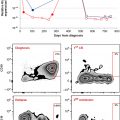Hematopoietic Cell Transplantation in Adult Acute Lymphoblastic Leukemia
1Rambam Health Campus, Haifa, Israel
2Israel Institute of Technology, Haifa, Israel
3Shaare Zedek Medical Center, Jerusalem, Israel
Multiple Choice and Discussion Questions
1. Which of the following patient(s) should be considered for upfront allogeneic transplantation assuming the availability of MSD for all of the patients?
- 16-year-old female with precursor B-cell ALL, positive BCR–ABL1 fusion gene, and in molecular remission
- 56-year-old female with precursor B-cell ALL, positive BCR–ABL1 fusion gene, and in molecular remission
- 35-year-old male with precursor B-cell ALL and normal cytogenetics who presented with a WBC count of 15,000/μL with predominant lymphocytes
- 35-year-old male with precursor B-cell ALL and MLL–AF4 gene fusion, and in molecular remission following 4 weeks of therapy
Before discussing each case separately, a short discussion regarding standard and high-risk ALL is appropriate. The generally accepted prognostic factors defining high risk are age, WBC count, immunophenotyping, high-risk cytogenetics and mutations, and response to induction therapy. OS ranges from 34% to 57% for patients younger than 30 years compared with only 15% to 17% for patients older than 50 years. A WBC count greater than 30,000/μL or 50,000/μL for B-lineage ALL and greater than 100,000/μL for T-lineage ALL is associated with poor prognosis. T-lineage ALL also appears to have better outcomes than B-lineage ALL. The presence of the Ph chromosome or t(4; 11)(q21; q23) has been associated with inferior survival in multiple large series. Additionally, the presence of t(8;14)(q24.1;q32), complex karyotype defined as ≥5 chromosomal abnormalities, or low hypodiploidy or near triploidy was noted to have poor survival in the UKALL XII–ECOG 2993 trial. However, even in the standard-risk group, the relapse rate approaches 40–55%. In order to better sort the standard-risk group, the GMALL trialists performed serial measurements of minimal residual disease (MRD) by flow cytometry after induction chemotherapy in 196 standard-risk patients. The 10% of patients who had a rapid MRD decline to lower than 10−4 or below detection limit at day 11 and day 24 had a 3-year relapse rate of 0%. Using MRD as a tool for making clinical therapeutic decisions regarding the best consolidation therapy may be highly beneficial in the future and currently is tested in clinical trials. MRD as a prognostic tool may indeed supersede other established prognostic markers. As discussed previously, the pivotal role of allogeneic SCT in the setting of Ph+ ALL patients in CR1 is very well established. Thus, the 16-year-old female with Ph+ B-cell ALL in molecular remission should definitely be considered for upfront allogeneic SCT.
The second case, of a 56-year-old female with the same clinical scenario, is more challenging. In the UKALL XII–ECOG 2993 trial, performing a myeloablative allogeneic SCT in the high-risk group (most of these were patients older than 35 years) did not translate into improved OS due to high rates of nonrelapse mortality, most of them due to GVHD or infections. However, the rate of relapse was significantly lower in the high-risk group patients who were transplanted in CR1. The availability of reduced-intensity conditioning (RIC) protocols has made allogeneic SCT an attractive therapeutic option for elderly patients with Ph+ ALL. In the relatively small single-center study conducted in high-risk ALL patients (median age: 56 years), the subgroup of Ph+ ALL patients receiving nonmyeloablative conditioning at CR1 had a 3-year OS of 62% with a relapse rate of 32%. Considering that beyond CR1, SCT is curative in only a minority of patients, we conclude that this patient should be treated with an upfront RIC allogeneic SCT followed by TKI therapy.
The third patient is defined as a “pre-therapy” standard-risk patient. There is no information regarding his MRD status at the end of induction therapy. Nevertheless, data exist supporting performing an upfront allogeneic SCT for standard-risk young ALL patients in CR1. This was the main finding of the UKALL XII–ECOG 2993 trial as well as the HOVON trial, and it was later validated by meta-analyses. Thus, unless this patient has a negative MRD in a very reliable laboratory on days 11 and 24, we would recommend an upfront allogeneic SCT.
The fourth patient has the cytogenetic translocation t(4:11), which is associated with an adverse prognosis. However, after 4 weeks of induction therapy, he is in complete molecular remission. Does MRD negativity after 4 weeks of induction therapy overcome the adverse prognosis of t(4:11)? This question is very hard to answer as patients with rare adverse prognostic factors are usually diluted within the whole ALL population. An early study demonstrated the prognostic power of MRD monitoring in this rare biologic entity; however, there are no data regarding MRD-based intervention in t(4:11) ALL patients. Furthermore, currently, there is no consensus regarding standardization of MRD measurement techniques or MRD monitoring intervals. Therefore, we conclude that outside the setting of a clinical trial, this patient should be offered an upfront allogeneic SCT.
• In the absence of an MSD, should any of the patients presented in Question 1 be considered for autologous transplantation?






